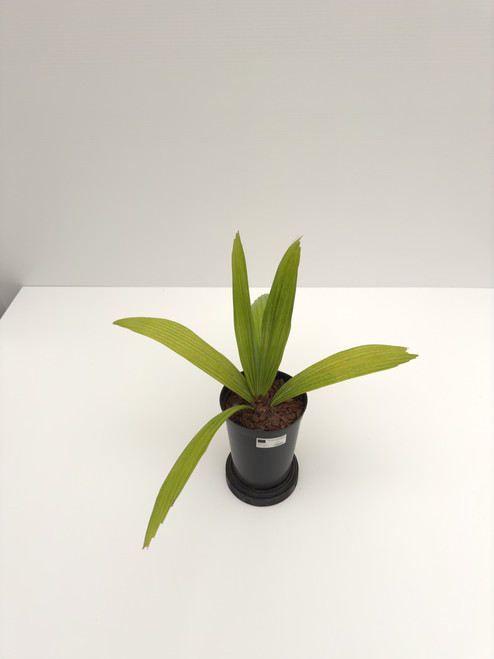Product Description
Habitat and Distribution
Borneo, China Southeast, Jawa, Malaya, Society Is., Kampuchea, Thailand, Malaysia, Indonesia and the Philippines.
Description
Hermaphroditic, Solitary palm. Trunk to 40 m tall, 15-65 cm in diameter; breast high, leaf scars raised, internodes broad, petiole stubs persistent in the basal 2 m or so. Leaves 25- 30 in a ± globose crown; petiole arching, 100-200 cm long, to 12 cm wide in proximal portion, to 15 mm wide in distal portion, adaxially flat to slightly ridged, glabrous, green to green-purple to green-red, glossy, frequently with a reddish-purple longitudinal stripe; margins with large, single, retrorsely recurved, green to brown spines 10-60 mm long, largest and closer in the proximal portion; leaf-base fibres moderately fibrous, coarse, persistent; lamina costapalmate, irregularly segmented, with segments grouped and with divisions between each group of segments deeper into the lamina than the divisions between individual segments, subcircular, 80-200 cm long, 150-170 cm wide, adaxially green, abaxially a similar green; lamina divided into groups of 2-12 segments separated from adjacent groups by a deep split that almost reaches the hastula; lamina divided for 37-78% of its length, with 80-90 segments, depth of apical cleft 19-50% of the segment length, apical lobes pendulous; parallel veins 6-7 each side of midrib; transverse veins thinner than parallel veins. Inflorescences unbranched at the base, 60-230 cm long, not extending beyond the limit of the crown, curving, branched to 4 orders; partial inflorescences 4-9, 45-60 cm long; prophyll not seen; peduncular bract(s) lacking; rachis bracts loosely sheathing, glabrous; rachillae 15-45 cm long, drooping, yellow, glabrous. Flowers in clusters of 3-5, 1.5-1.75 mm long, yellow; sepals suborbicular; petals broadly triangular, obtuse. Fruit globose, or ellipsoid to reniform, 11-25 mm long, 10-18 mm in diam., often bilobed, glossy blue to purple; epicarp thin with scattered lenticellular pores; suture line extends for full length of the fruit, marked with lip-like structures; mesocarp fleshy, 1.0- 1.5 mm thick; endocarp crustaceous; pedicel 1-3 mm long, ca 3 mm wide. Seed globose to ellipsoid, 9-24 mm long, 9-10 mm in diam., apically pointed; endosperm intruded for ca half its width; embryo lateral. Eophyll 6-8- ribbed. (Dowe, J.L.)/Palmweb. Editing by edric.
Culture
Sunny, moist, but well drained position. Quite cold tolerant when older. Hardiness, zone: 9b
Comments and Curiosities
Phenology: Flowers Mar.-July; fruits June-Sept.
Conservation: Vulnerable. (Dowe, J.L.)/Palmweb.
"Great Livistona (though most are, in my opinion). This one has very large, deep-lime green, deeply split, nearly completely circular fan leaves that droop at the tips when a bit older. Its most striking feature are its monstrous, sharp black teeth that line the petioles (be very careful when trimming). It is not a great palm for full sun in the hot inland climate of So Cal, but it will survive. A maturing palm is growing nicely in the San Diego Zoo. Nearer the coast, and in Florida it does great in full sun. In even more tropical climates it is a fast and robust palm. In my garden in the San Fernando Valley this palm is growing pretty well in partial shade, but still only four feet tall after 10 years." (Geoff Stein)














